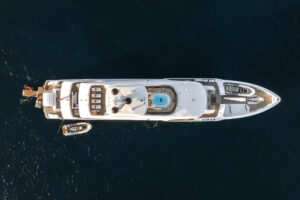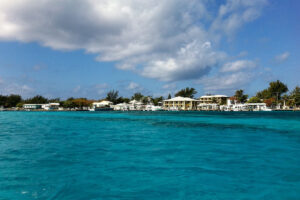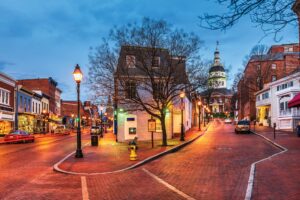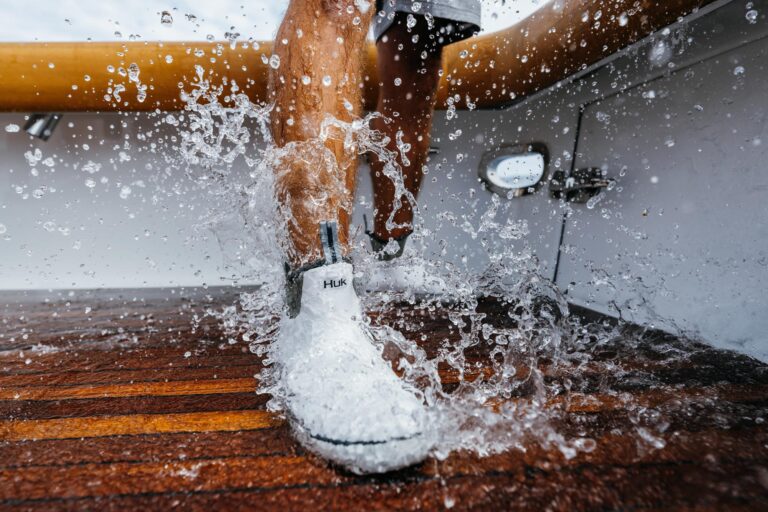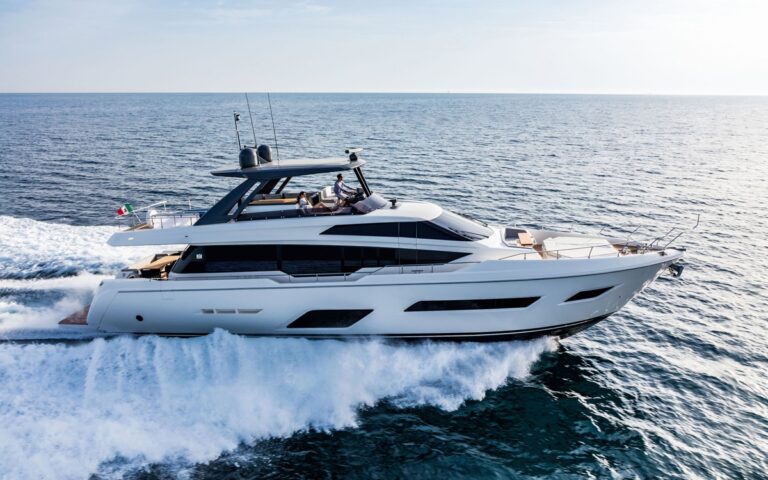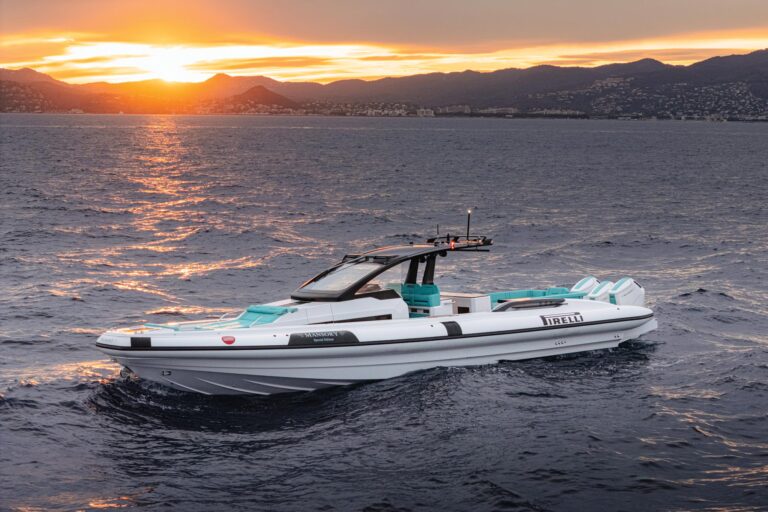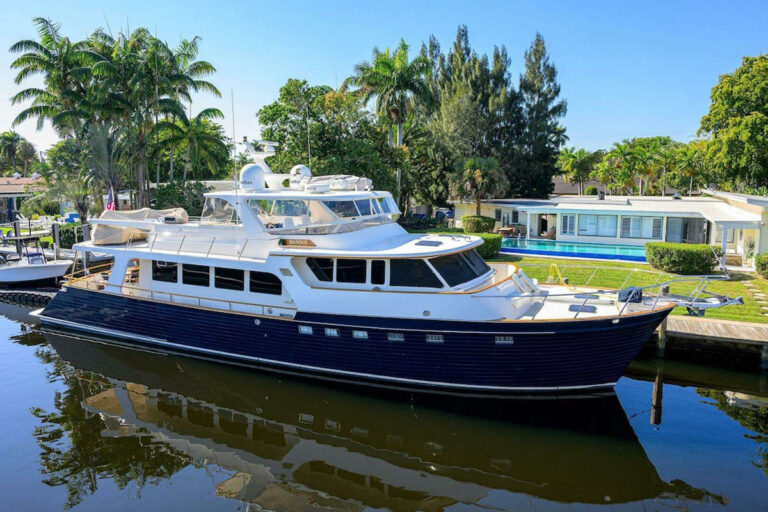Rangiroa, Tuamotu Islands
I can’t speak for other marine photographers, but when I’m motoring around in a dinghy with my camera in hand, my mind is always searching for that perfect tropical beach, the deserted one with a few droopy palms reaching quietly over the water. Well, I found it here on Rangiroa, one of the atolls in the French Polynesian island group called the Tuamotus. These low-lying coral atolls have some of the clearest water in the world. The snorkeling, diving and fishing can’t be beat. The water is warm, the beaches are white and the few boats around respect the peaceful ambience. Sure, there are a few cruising yachts at anchor in the main town of Rangiroa, but the paradise shown here extends along many outlying beaches. This place is the type of venue where I always find myself looking off the stern and thinking, “If I only had a few more days-no, weeks-no, months…”
-Onne van der Wal
Moorea, Society Islands
Moorea is a tiny island just a few miles off Tahiti. Every South Pacific cruiser should stop in one of Moorea’s bays, which are among the finest anchorages in the Society Island chain that includes Tahiti and several other lush, mountainous islands. All are circled by coral reefs and surrounded by tranquil lagoons. The best way to get here is by boat, but a flight to Tahiti followed by a 10-minute shuttle to Moorea will get you to this spot. It’s hard to resist a few nights off the boat in one of Moorea’s lagoon bungalows, where local Tahitian girls fill outriggers with fresh fruits, fish and pastries, then paddle to your room. This photo was taken near the mouth of Robinson’s Cove in the early morning.
-Neil Rabinowitz
Baths, Virgin Gorda
The Baths, on Virgin Gorda in the British Virgin Islands, is one of the most intriguing beaches in the world. The Virgins are slightly arid without the lush green hillsides often associated with tropical islands, but the white beaches and turquoise waters offer some of the finest swimming and snorkeling on Earth. Palms and piles of building-size boulders line the shoreline; the tide rushes through, and sunlight pierces the mazes of rock and sand, the knee-deep wading pools and the mysterious passageways. No wonder the Baths is one of the Caribbean’s most popular day anchorages for Caribbean charter yachts, with children and adults alike spending days crawling, climbing and exploring.
-Neil Rabinowitz
San Juan Islands
This West Bay 58 was our cruising home as we wandered just off Sydney, British Columbia, through the Canadian Gulf Islands, known as the San Juans when they spill over the U.S. border. The San Juans are a pastoral group of islands, some mountainous and some drowning at high tide, many wooded with firs, cedars and madroños and frequented by hundreds of bald eagles, deer and resident pods of killer whales. The islands never ice up, so they offer year-round cruising. Many marine parks are accessible only by cruising yachtsmen, and many public shores are reachable only by boaters with initiative. The area is like a West Coast version of Maine’s most remote islands, though without the lobster-pot concerns.
-N.R.
Espiritu Santo Island
Espiritu Santo Island is a hot-water, desert-like island off the Baja Coast of Mexico, near La Paz. It is one of the most popular Baja cruising destinations for powerboaters and sailors who don’t mind turning on their engines once in a while. After making the turn around Cabo San Lucas and heading back up the inside coast, yachtsmen will encounter waters teeming with gray whales, marlin, manta rays, pelicans and, if you look really hard, scorpions.
-Neil Rabinowitz
Virgins Bay, Marquesas
Sunset is why photographers venture to Virgins Bay off Hanavave village on Fatu Hiva, one of the islands in the Marquesas chain along the top of French Polynesia. I’m no different, but I wanted to see as much as I could before the sky began to change. I found myself high above the bay that afternoon, swimming in a lake above a waterfall after getting to know some of the locals working to excavate old village and burial ground ruins. I was much too comfortable in that lake, high above the volcanic peaks, black beaches and green water, so comfortable that the sun began to dip down before I was ready. I radioed the tender to be waiting at the dock with the engine running, then slid down the waterlogged trail I had so carefully hiked up just a few hours before. My feet still caked in mud, I leapt into the dinghy and motored into the harbor in a race against the sun. I managed to squeeze off only 10 shots that evening. This is one of them.
-Onne van der Wal
Maui, Hawaiian Islands
I lived in Hawaii for years and know that, pre-development, the Hawaiian islands were surely the closest thing to heaven on earth … except for the warlike natives. The Hawaiian islands, while lacking the tranquil lagoons of the Societies, offer the finest beaches, dramatic surf, towering green mountains and breathtaking valleys. Although heavily visited by tourists, Hawaii is a treasure for adventurous travelers who step off the beaten path. Back roads, hidden trails and an abundance of “almost” inaccessible beaches make Hawaii’s hidden spots as beautiful as ever. Yachtsmen will find only a few protected coves on each island, but that is enough of a toehold to launch explorations ashore. A good one is here, at Wainapanapa, near the black and volcanic beaches of Hana on the East Coast of Maui.
-Neil Rabinowitz
South Island, New Zealand
My first shoot at Lake Southerland was with a National Geographic pilot who arrived in a small chopper with a Craftsman socket set sliding about the floor, a Manila rope seat belt and a cockpit slimy with pools of fresh deer blood. Apparently, you can hunt deer from the air. I lashed myself in and we reverse-corkscrewed upward in the spray of New Zealand’s Southerland Falls, which plunges from glacial heights to the tropical valley bottom, where the lake disappears in the rock seen here.
-Neil Rabinowitz
Antigua
My first landfall on my way to the United States in 1979 was Antigua. I had sailed nonstop from Cape Town, South Africa, and had been at sea for 30 days when we arrived at English Harbour and were greeted by a woman named Mavis. She took our docklines and asked if she could do our laundry-a true angel. Today’s cruising yachtsmen will be happy to know Mavis is still there, though most of the big boats no longer go to English Harbour, opting instead for Falmouth Harbour, which used to take only the spillover population of yachts. This shot shows both anchorages.
-Onne van der Wal
Vancouver Island, British Columbia
The city of Victoria, on Vancouver Island, offers boaters a strong sense of European style in a North American context. Only a few hours northwest of Seattle and a few southeast of Vancouver-and just minutes from the Gulf and San Juan Islands-the city is poised at the eastern end of the Strait of Juan de Fuca, a waterway to the Pacific. This photograph captures Inner Harbor, with the Parliament building in the background. The landmark greets many yachtsmen who charter in the Northwest and visit this quaint city’s ivy-covered, red-brick turrets and patina-topped domes. Visitors can enjoy buggy rides and provincial museums lined with rose gardens. Ferries of all varieties-from high-speed to cruise-liner-join float planes, land planes and commuter helicopters in making Victoria’s marina one of the easiest to reach on any island, anywhere. The city has the foreign flair of Old Montreal and an abundance of charter services and yacht clubs.
-Neil Rabinowitz
Abacos, Bahamas
When I decided to show my mother the Bahamas for the first time, I knew exactly where to go. The Abacos are so close to the Northeast, you can be on board by lunchtime, which made the trip easy. Mom had never had an interest in sticking her head underwater to see fish, but I knew that once she saw the crystal-like beauty of the water in this part of the world, we’d have a hard time getting her back in the boat. And so it was at this spot, about an hour’s cruise from Marsh Harbor. To help her remember the place and her first underwater adventures, I took this shot with a waterproof housing around a camera at water level, half submerged. The water may appear empty to most, but it is full of wonderful memories for us.
-Onne van der Wal
Culebra, Spanish Virgin Islands
The Spanish Virgin Islands are a little-known cluster of dry, scrub-covered islands wedged between Puerto Rico and the U.S. Virgins. Fringed with sweeping, uninterrupted beaches and gentle hills, the islands offer terrific holding ground in many protected coves with idyllic beach walks, great sportfishing and starlit nights far from any city or airport. The islands are networked with easy-going sand-covered footpaths that run from beach to beach. Locals are friendly. The Spanish Virgins are an easy trip from either direction, but relatively few boats stop because they are in a hurry to reach St. Thomas or Puerto Rico. Only recently has this spot been discovered by charter companies.
-Neil Rabinowitz
Mount Desert Island, Maine
Here in the land of lobster, blueberries, pink granite, schooners and Yankee charm, Maine’s Mount Desert Island welcomes elegant yachts and Down East fishermen with equal grace. The area’s New England charm and rich nautical history make it one of America’s greatest boating destinations. If you escape the tourists who overrun Bar Harbor in mid-summer, you can find numerous coves filled with storybook New England scenes and real communities that work and live with the sea. The photo at left was taken at Acadia National Park, along Ocean Drive.
-Neil Rabinowitz
Vavau Group, Tonga
I like this photograph because it conveys the true beauty of Tonga-pristine water and beaches void of tourist shops and bars. This is one of the few places I’ve visited where I felt nature completely shrouding me from the harshness of civilization. The people of Tonga have an incredible pride in their land, and they encourage visitors to enjoy it as they do. The attitude offers a lovely change of pace from some other island chains, where tourists are seen more as walking wallets than eager explorers.
-Onne van der Wal
Seychelles
This archipelago boasts about 115 islands in the western Indian Ocean, north of Madagascar and east of Kenya. The outer islands are coralline and flat with the kinds of beaches seen here; the 35 or so islands in the inner group are rocky and hilly with little to no shoreline. The giant tortoise, which survived near extinction and graces the republic’s coat of arms, now numbers more than 100,000 and joins other exceptional wildlife in the Seychelles, where nearly half the total area is nature parks and reserves. As a measure of mankind’s presence, it’s interesting to note the first airport did not open until 1971-and the opening was attended by nearly the entire population, according to public records.

